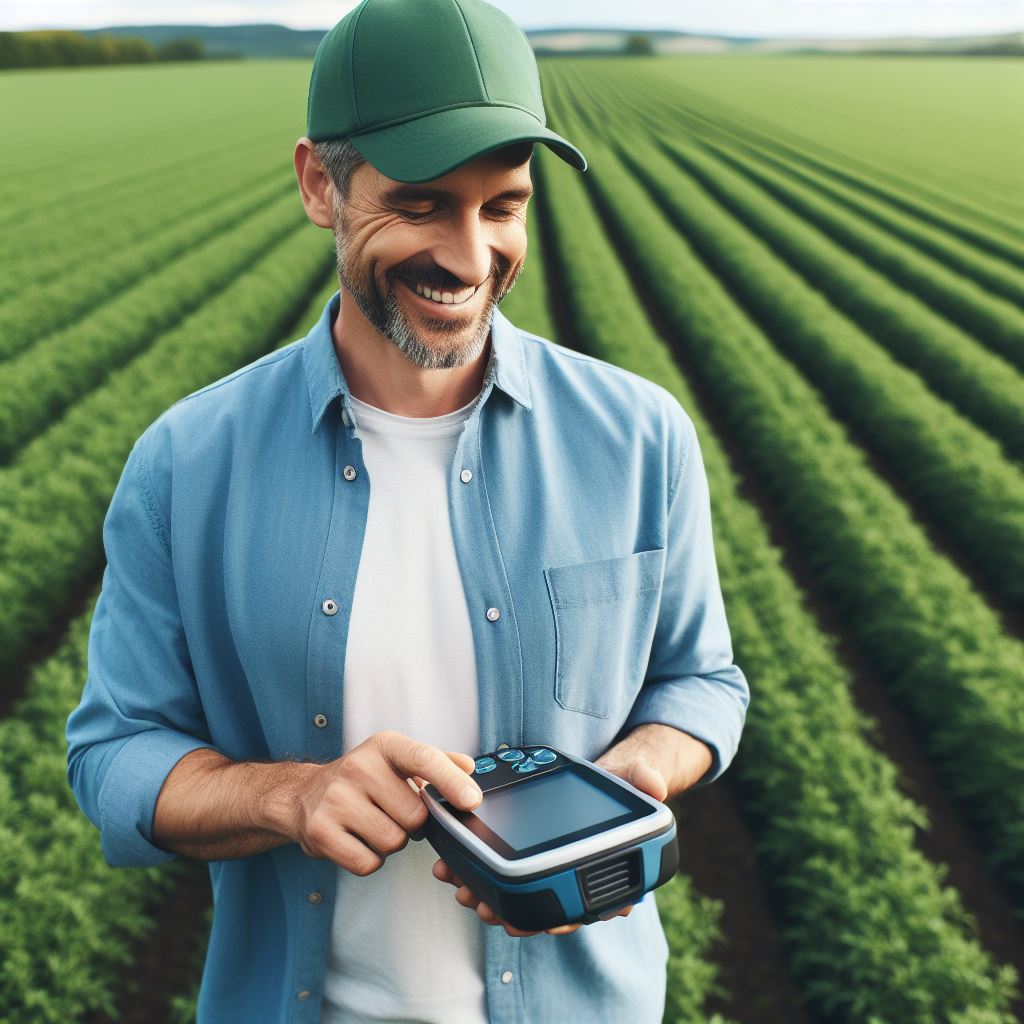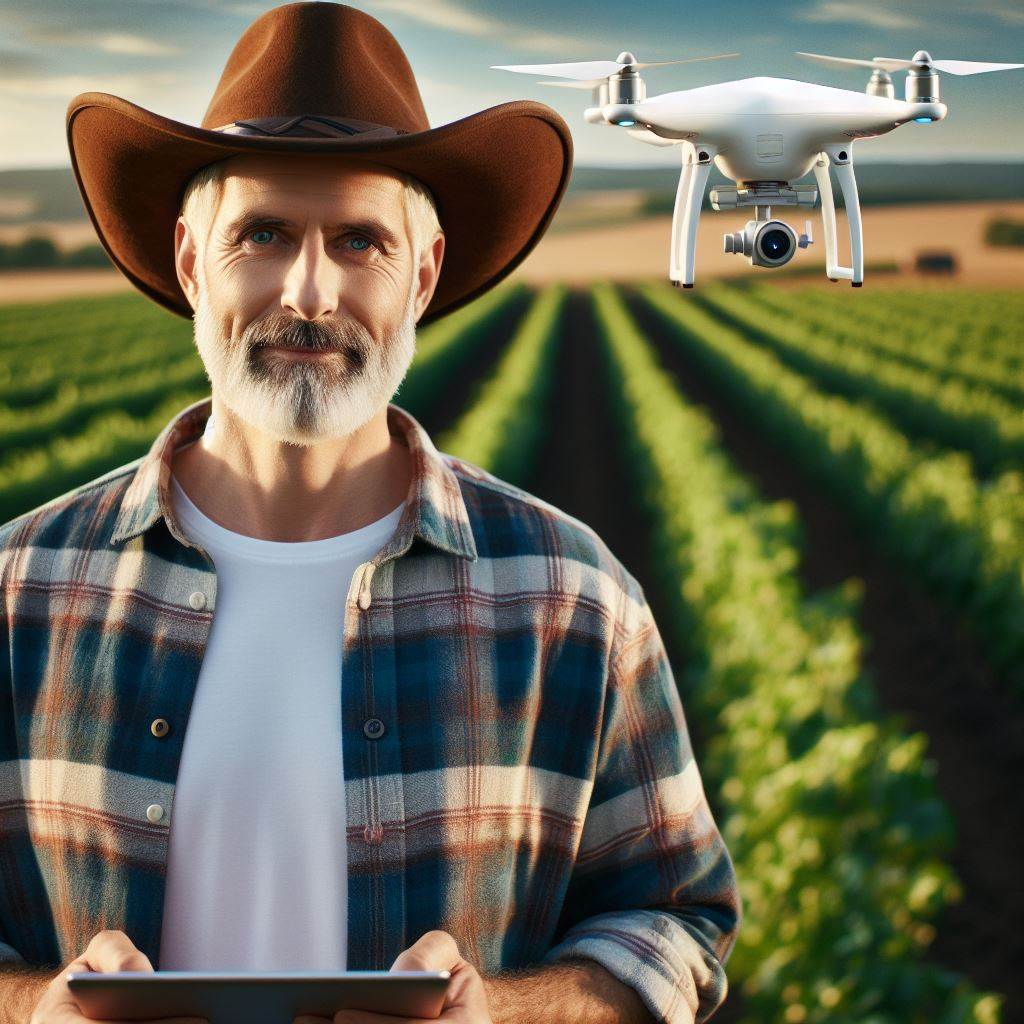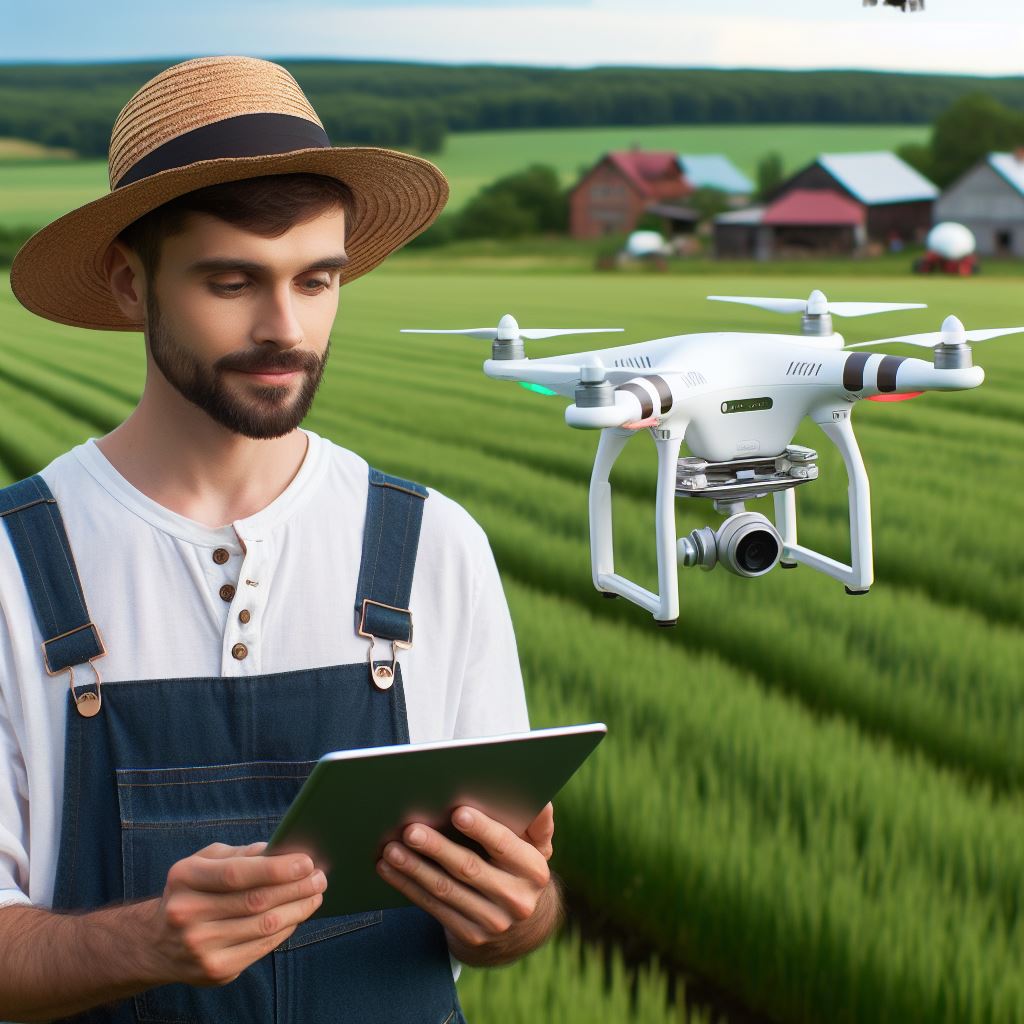Introduction
GPS technology is a navigation system that uses satellite signals to determine precise locations.
GPS is crucial in agriculture as it improves efficiency, reduces costs, and enhances productivity.
Thesis statement: GPS revolutionizes agriculture by optimizing resource management, facilitating precision farming, and improving yield.
In recent years, the integration of GPS (Global Positioning System) technology into farming practices has sparked a profound revolution in agriculture, reshaping traditional methods and offering a myriad of opportunities for increased efficiency, productivity, and sustainability.
This technological marvel, originally developed for military purposes, has found its way into the hands of farmers worldwide, becoming an indispensable tool in modern agricultural practices.
From precision planting to targeted pesticide application and even livestock management, GPS has permeated every aspect of the agricultural landscape, promising to redefine how we cultivate the land and feed the world.
In this exploration, we delve into the transformative power of GPS in farming, uncovering its multifaceted applications, the benefits it brings to farmers and the environment, and the potential it holds for shaping the future of food production on a global scale.
Benefits of Using GPS in Farming
Using GPS technology in farming not only allows farmers to accurately track their crops but also brings numerous benefits to their operations.
In this section, we will explore the advantages of using GPS in farming and how it revolutionizes modern agricultural practices.
A. Enhanced precision in field operations
- Precise planting and seeding are made possible with GPS. Farmers can precisely mark planting locations and ensure uniform seed distribution, leading to better crop growth.
- Accurate application of fertilizers and pesticides is crucial for crop health. GPS guides farmers in applying these substances precisely, reducing environmental impact and optimizing plant growth.
B. Efficient use of resources
- Reduced overlap and waste are significant advantages of GPS in farming. Farmers can avoid overlapping activities such as fertilizing or spraying, reducing costs and environmental consequences.
- Optimization of irrigation is essential for water conservation. GPS technology helps farmers distribute water efficiently by identifying areas with moisture deficits and adjusting irrigation systems accordingly.
C. Time and labor savings
- Reduced manual labor is one of the main benefits of GPS in agriculture. With accurate GPS guidance, farmers can automate machinery, reducing the need for manual labor and increasing efficiency.
- Improved navigation and route planning save farmers time and effort. GPS devices help farmers find the most efficient routes within their fields, optimizing transportation and reducing delays.
In short, GPS technology has revolutionized agriculture by providing enhanced precision, efficient resource utilization, and time and labor savings.
With precise planting and seeding, farmers can maximize crop growth, while accurate application of fertilizers and pesticides ensures optimal plant health.
Reduced overlap and irrigation optimization help farmers save resources and protect the environment.
Additionally, the reduction in manual labor and improved navigation provided by GPS devices further increase the efficiency of farming operations.
The benefits of GPS in farming are clear, making it an indispensable tool for modern agriculture.
Read: Climate-Smart Farming Innovations
Transform Your Agribusiness
Unlock your farm's potential with expert advice tailored to your needs. Get actionable steps that drive real results.
Get StartedImproved Crop Monitoring and Management
By harnessing the power of GPS technology, farming becomes more efficient and sustainable.
The improved crop monitoring and management that GPS provides have numerous benefits for farmers.
A. Real-time monitoring
Real-time monitoring allows farmers to detect any crop health issues, such as nutrient deficiencies or water stress, early on.
This early detection enables prompt intervention, preventing further damage and increasing overall crop health.
In addition, GPS helps identify diseases and pests, which can be detrimental to crop production.
By monitoring fields in real-time, farmers can spot signs of infestations and take immediate action to contain and control them.
This minimizes yield losses and reduces the need for excessive pesticide use.
B. Mapping field data
Mapping field data with GPS is another valuable tool for farmers.
Yield mapping provides a visual representation of crop performance across different areas of the field.
This helps identify variations in productivity and pinpoint potential problem areas that require further investigation.
Furthermore, precise soil sampling and analysis allow farmers to understand the specific characteristics of their soil.
GPS technology provides accurate data on soil composition, pH levels, and nutrient content.
Armed with this information, farmers can make data-driven decisions about fertilizer application, potentially reducing costs and minimizing environmental impact.
By using GPS, farmers can save time and resources by targeting specific areas of their fields that require attention.
Transform Your Agribusiness Online Presence
Stand out with compelling content tailored to engage your audience and drive results. From blog posts to social media, we’ll create what your business needs to grow.
Get StartedThis precision farming approach prevents over-application of inputs in areas where they are not needed, reducing waste and increasing cost-effectiveness.
GPS technology also enables better record-keeping and data management.
By having accurate and up-to-date information about field conditions and crop performance, farmers can track progress over time and analyze trends to improve future decision-making.
In fact, GPS technology revolutionizes agriculture by improving crop monitoring and management.
Real-time monitoring, crop health assessment, disease and pest detection, yield mapping, and soil sampling are all made more effective and efficient with the use of GPS.
Farmers can optimize yields, reduce costs, and minimize environmental impact by harnessing the power of GPS in farming.
Read: Precision Ag: Revolutionizing Farms
Integration with Machinery and Equipment
In the ever-evolving world of agriculture, the incorporation of GPS technology has truly revolutionized farming practices.
Not only has it simplified the process of navigation, but it has also brought about substantial improvements in productivity, efficiency, and sustainability.
The integration of GPS with machinery and equipment has played a vital role in this transformation.
A. Autosteering systems
Autosteering systems have become an indispensable tool for farmers. These systems utilize GPS to guide agricultural machinery with precision navigation.
By following predetermined paths, machinery can be directly programmed to cover specific areas.
This not only saves time but also ensures that no portions of the field are missed.
Farmers can rely on autosteering systems to accurately navigate through their fields, making their operations more efficient than ever before.
Unlock Farming Insights for Growth
Make smarter farming decisions with detailed reports on market trends, weather patterns, and soil health tailored to your farm's success. Boost productivity with actionable data.
Get ReportThe precise navigation capabilities offered by autosteering systems are a game-changer.
Farmers can now set up automated routes for their machinery, allowing for consistent and accurate coverage of the fields.
This enables them to maximize productivity by minimizing overlap and optimizing the use of resources.
Furthermore, autosteering systems significantly reduce the occurrence of human error in farm operations.
By taking over the steering, GPS technology eliminates the possibility of human mistakes, such as uneven spraying or missed sections.
This ensures that crops receive the necessary treatments and enhances the overall quality of farm outputs.
B. Variable rate technology
Variable rate technology is another remarkable aspect of GPS integration in farming.
With GPS-enabled machinery, farmers can apply inputs in a customized manner, tailoring them to each specific area of the field.
Customized application of inputs based on GPS data allows farmers to optimize resource utilization.
Fertilizers, pesticides, and other inputs can be applied precisely where needed, preventing unnecessary application and reducing wastage.
This not only saves costs but also minimizes environmental impacts associated with excessive use of chemicals.
Additionally, variable rate technology enables farmers to adapt to field variability.
GPS data provides insights into soil conditions and other factors that affect crop growth.
By precisely adjusting input application rates, farmers can address specific field variations, ensuring optimal crop health and yield potential.
The integration of GPS technology with machinery and equipment has undeniably transformed the way farming is done.
From precise navigation and reduced human error to customized input application and adaptation to field variability, the benefits are numerous.
As technology continues to advance, the potential for further innovation in GPS-enabled farming practices is vast.
Farmers who embrace these advancements stand to gain significant advantages in terms of productivity, profitability, and sustainability.
GPS has truly revolutionized the agricultural landscape and will continue to shape the future of farming.
Read: Moisture Sensors: Boosting Crop Yields

Precision Livestock Farming
Precision Livestock Farming, utilizing GPS technology, has transformed the agricultural sector by revolutionizing how livestock are tracked and monitored, as well as identifying optimal breeding and feeding locations.
This innovative approach has resulted in improved animal health, welfare, and productivity, while also allowing for cost-effective resource allocation.
A. Tracking and monitoring livestock
GPS technology has enabled farmers to efficiently track and monitor the movements of their livestock in real-time.
This has proven invaluable in managing pasture grazing, ensuring that animals are rotated between different areas to optimize grass quality and quantity.
Furthermore, GPS tracking allows farmers to promptly detect any irregular behavior in their livestock, indicating potential health or welfare issues.
By identifying these problems early on, farmers can intervene promptly, providing the necessary care and treatment to ensure the well-being of their animals.
B. Identifying optimal breeding and feeding locations
Precision Livestock Farming also utilizes GPS technology to identify the most suitable breeding and feeding locations for livestock.
By analyzing GPS data, farmers are able to determine areas with the best forage quality, promoting enhanced productivity and growth in animals.
Additionally, GPS helps farmers allocate resources more effectively by identifying areas where animals have already grazed.
This allows for cost savings in terms of reduced feed waste and improved utilization of available resources.
In essence, the integration of GPS technology in Precision Livestock Farming has significantly transformed the way livestock are managed.
By tracking and monitoring animals in real-time, farmers can ensure optimal pasture grazing and timely detection of any health or welfare issues.
Moreover, the identification of optimal breeding and feeding locations through GPS analysis results in improved productivity and cost savings.
This demonstrates the immense potential of GPS in revolutionizing agriculture by increasing efficiency and promoting sustainable practices.
Read: Irrigation Apps: Tech at Your Fingertips
Delve into the Subject: Sustainable Agri: Biotech’s Green Edge
Gain More Insights: Precision Agri: A New Era of Farming
Challenges and Future Perspectives
A. Initial investment and training
Implementing GPS technology in farming requires a significant initial financial investment.
Farmers need to purchase GPS-enabled equipment and software, which can be costly.
Farmers also need to undergo training to learn how to effectively use GPS technology.
This includes understanding the software, interpreting data, and utilizing the technology for precise farming practices.
B. Connectivity and data management issues
One major challenge in GPS farming is connectivity.
In remote rural areas, internet access may be limited, affecting the real-time transmission and analysis of data.
Data management is another concern.
Farmers need to efficiently organize and store the vast amount of data collected from GPS systems, ensuring easy access and retrieval.
C. Potential advancements in GPS technology
Despite the challenges, there are exciting prospects for future advancements in GPS technology for agriculture.
1. Integration with drones and remote sensing
GPS technology can be seamlessly integrated with unmanned aerial vehicles (UAVs) or drones for aerial monitoring and crop analysis.
By combining GPS data with remote sensors, farmers can gather valuable information about soil moisture levels, plant health, and yield predictions.
2. AI and machine learning applications
The integration of artificial intelligence (AI) and machine learning algorithms with GPS technology holds great potential.
By analyzing GPS data alongside historical weather patterns, crop models, and other variables, AI can provide farmers with valuable insights and recommendations.
In general, while there are challenges to implementing GPS technology in farming, such as the initial investment and training required, the benefits and potential advancements make it an exciting innovation for the agriculture industry.
With the integration of drones and remote sensing, as well as the application of AI and machine learning, GPS technology can revolutionize precision farming practices.
As advancements continue to be made, it is essential for farmers to adapt and embrace these technologies to improve productivity, resource management, and sustainability in agriculture.
Conclusion
GPS technology has revolutionized agriculture by providing farmers with accurate positioning data for various farming activities such as planting, spraying, and harvesting.
This has resulted in increased efficiency, reduced costs, and improved yields.
GPS technology has transformed the way farmers operate by enabling them to precisely navigate their fields, optimize resources, and make data-driven decisions.
It has eliminated guesswork and improved overall productivity in the agriculture industry.
The future of GPS in farming looks promising. With advancements in technology, we can expect more precise and integrated systems that connect GPS with other emerging technologies like drones and data analytics.
This will further enhance agricultural practices, promote sustainable farming, and help meet the growing demand for food.




